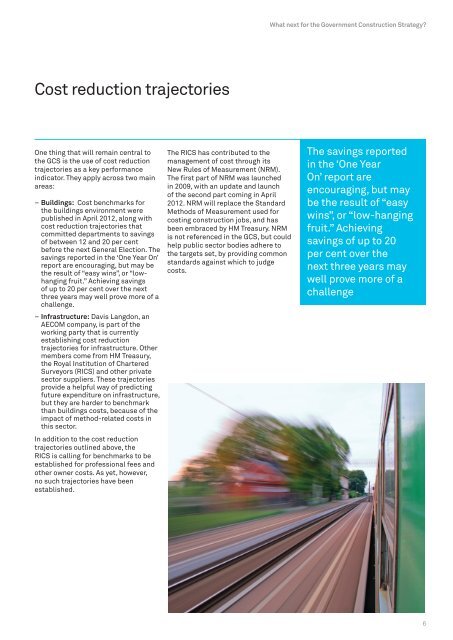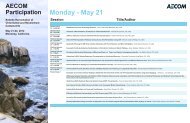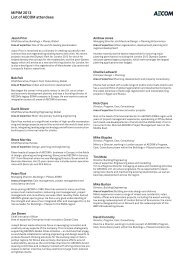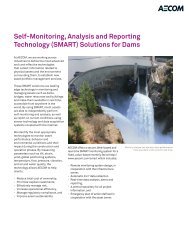What next for the Government ConstruCtion strateGy? - Aecom
What next for the Government ConstruCtion strateGy? - Aecom
What next for the Government ConstruCtion strateGy? - Aecom
Create successful ePaper yourself
Turn your PDF publications into a flip-book with our unique Google optimized e-Paper software.
<strong>What</strong> <strong>next</strong> <strong>for</strong> <strong>the</strong> <strong>Government</strong> Construction Strategy?<br />
Cost reduction trajectories<br />
One thing that will remain central to<br />
<strong>the</strong> GCS is <strong>the</strong> use of cost reduction<br />
trajectories as a key per<strong>for</strong>mance<br />
indicator. They apply across two main<br />
areas:<br />
––<br />
Buildings: Cost benchmarks <strong>for</strong><br />
<strong>the</strong> buildings environment were<br />
published in April 2012, along with<br />
cost reduction trajectories that<br />
committed departments to savings<br />
of between 12 and 20 per cent<br />
be<strong>for</strong>e <strong>the</strong> <strong>next</strong> General Election. The<br />
savings reported in <strong>the</strong> ‘One Year On’<br />
report are encouraging, but may be<br />
<strong>the</strong> result of “easy wins”, or “lowhanging<br />
fruit.” Achieving savings<br />
of up to 20 per cent over <strong>the</strong> <strong>next</strong><br />
three years may well prove more of a<br />
challenge.<br />
––<br />
Infrastructure: Davis Langdon, an<br />
AECOM company, is part of <strong>the</strong><br />
working party that is currently<br />
establishing cost reduction<br />
trajectories <strong>for</strong> infrastructure. O<strong>the</strong>r<br />
members come from HM Treasury,<br />
<strong>the</strong> Royal Institution of Chartered<br />
Surveyors (RICS) and o<strong>the</strong>r private<br />
sector suppliers. These trajectories<br />
provide a helpful way of predicting<br />
future expenditure on infrastructure,<br />
but <strong>the</strong>y are harder to benchmark<br />
than buildings costs, because of <strong>the</strong><br />
impact of method-related costs in<br />
this sector.<br />
In addition to <strong>the</strong> cost reduction<br />
trajectories outlined above, <strong>the</strong><br />
RICS is calling <strong>for</strong> benchmarks to be<br />
established <strong>for</strong> professional fees and<br />
o<strong>the</strong>r owner costs. As yet, however,<br />
no such trajectories have been<br />
established.<br />
The RICS has contributed to <strong>the</strong><br />
management of cost through its<br />
New Rules of Measurement (NRM).<br />
The first part of NRM was launched<br />
in 2009, with an update and launch<br />
of <strong>the</strong> second part coming in April<br />
2012. NRM will replace <strong>the</strong> Standard<br />
Methods of Measurement used <strong>for</strong><br />
costing construction jobs, and has<br />
been embraced by HM Treasury. NRM<br />
is not referenced in <strong>the</strong> GCS, but could<br />
help public sector bodies adhere to<br />
<strong>the</strong> targets set, by providing common<br />
standards against which to judge<br />
costs.<br />
The savings reported<br />
in <strong>the</strong> ‘One Year<br />
On’ report are<br />
encouraging, but may<br />
be <strong>the</strong> result of “easy<br />
wins”, or “low-hanging<br />
fruit.” Achieving<br />
savings of up to 20<br />
per cent over <strong>the</strong><br />
<strong>next</strong> three years may<br />
well prove more of a<br />
challenge<br />
6













